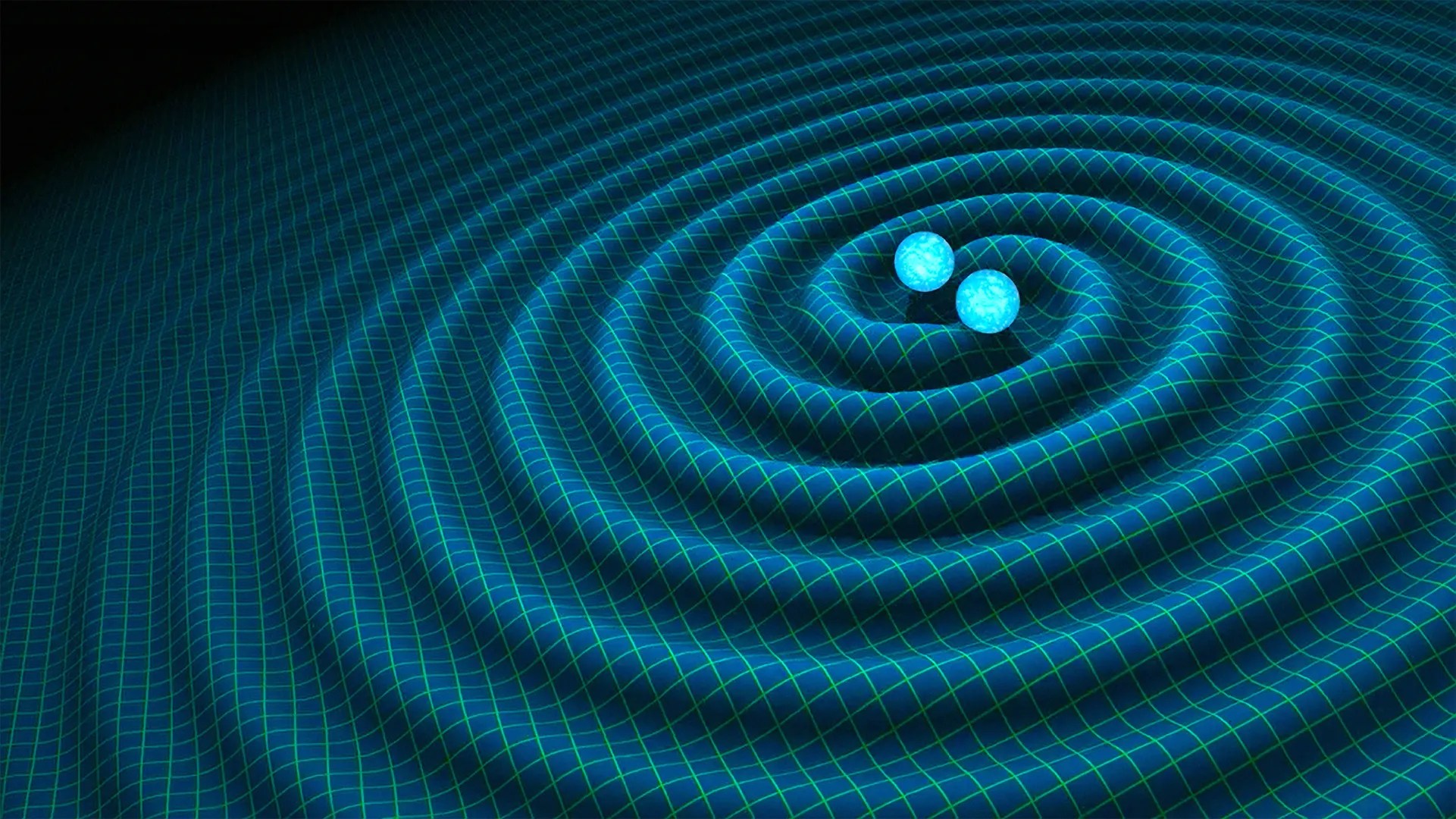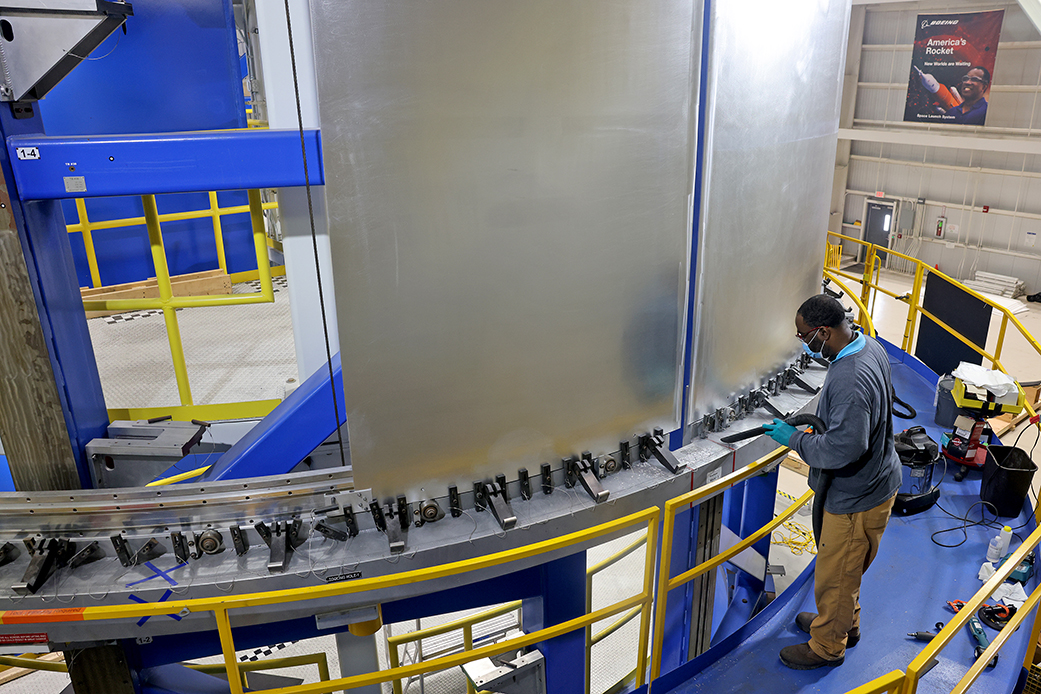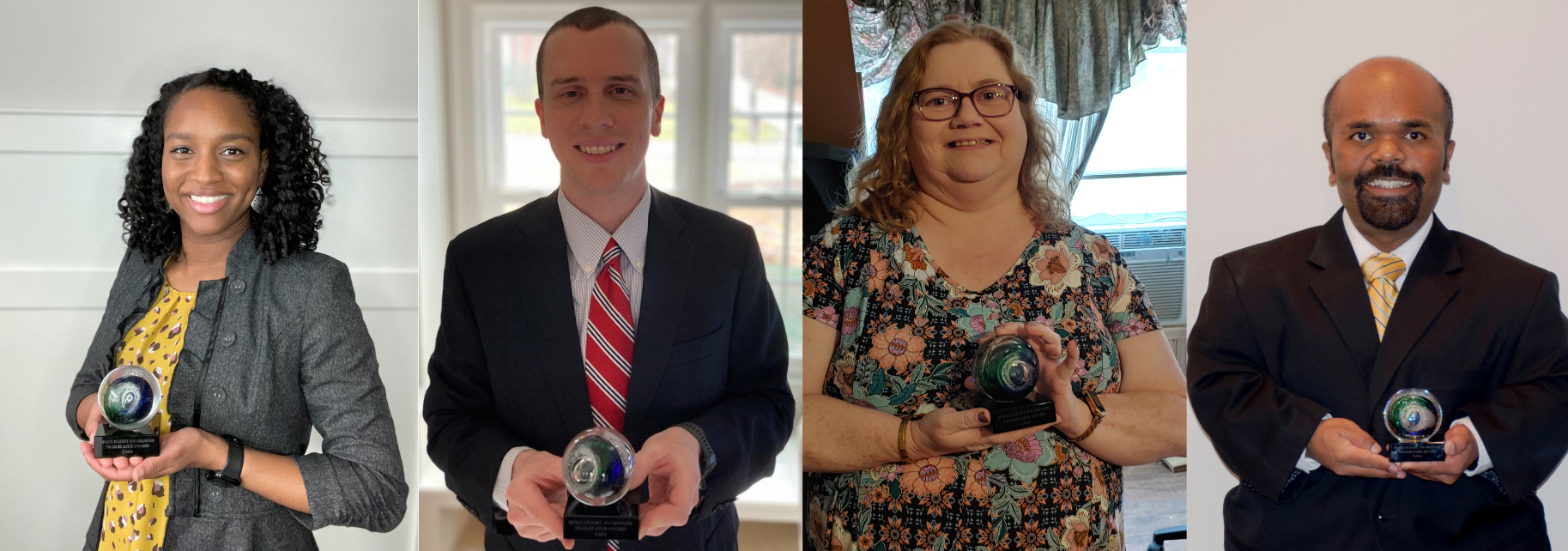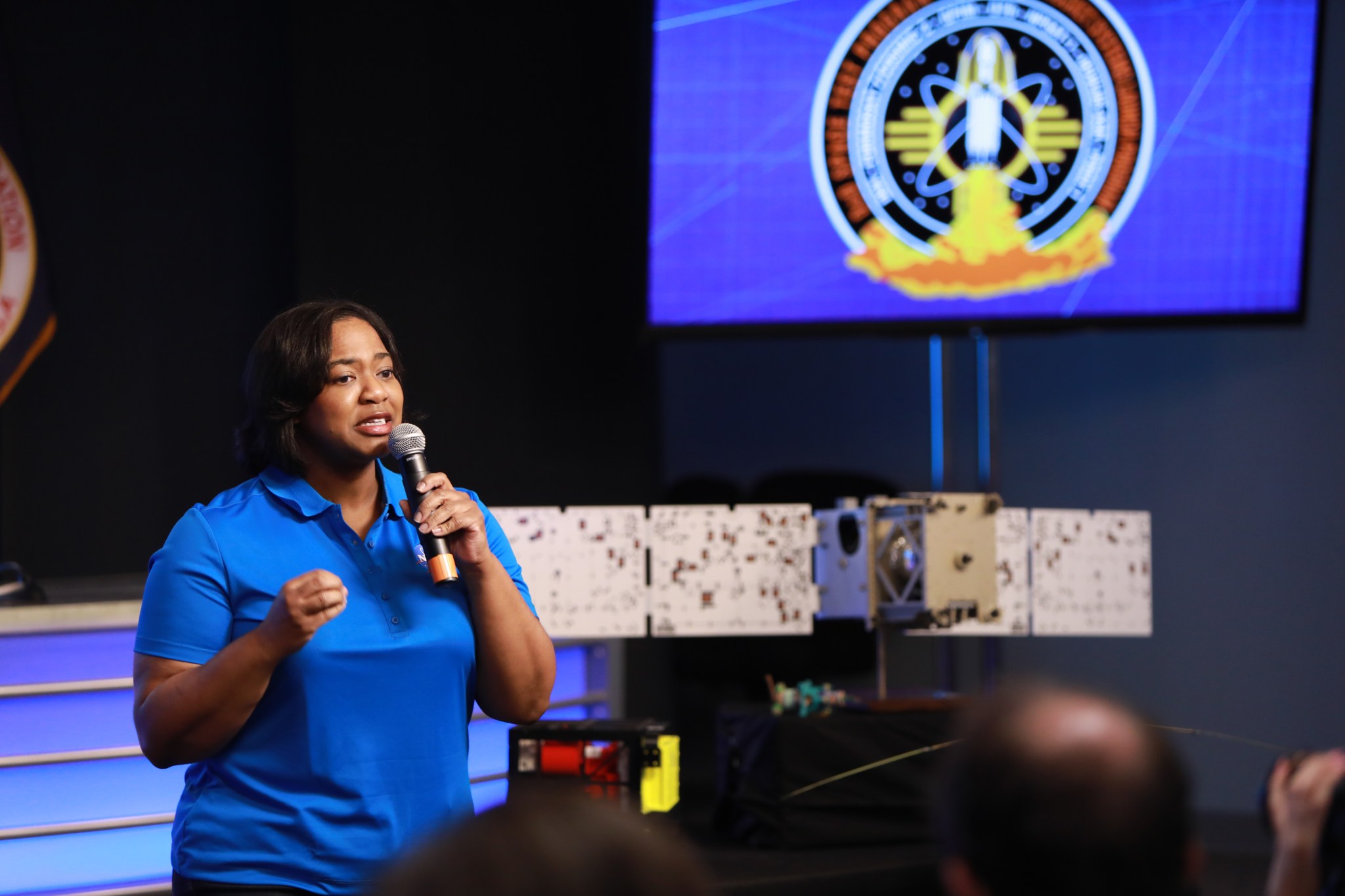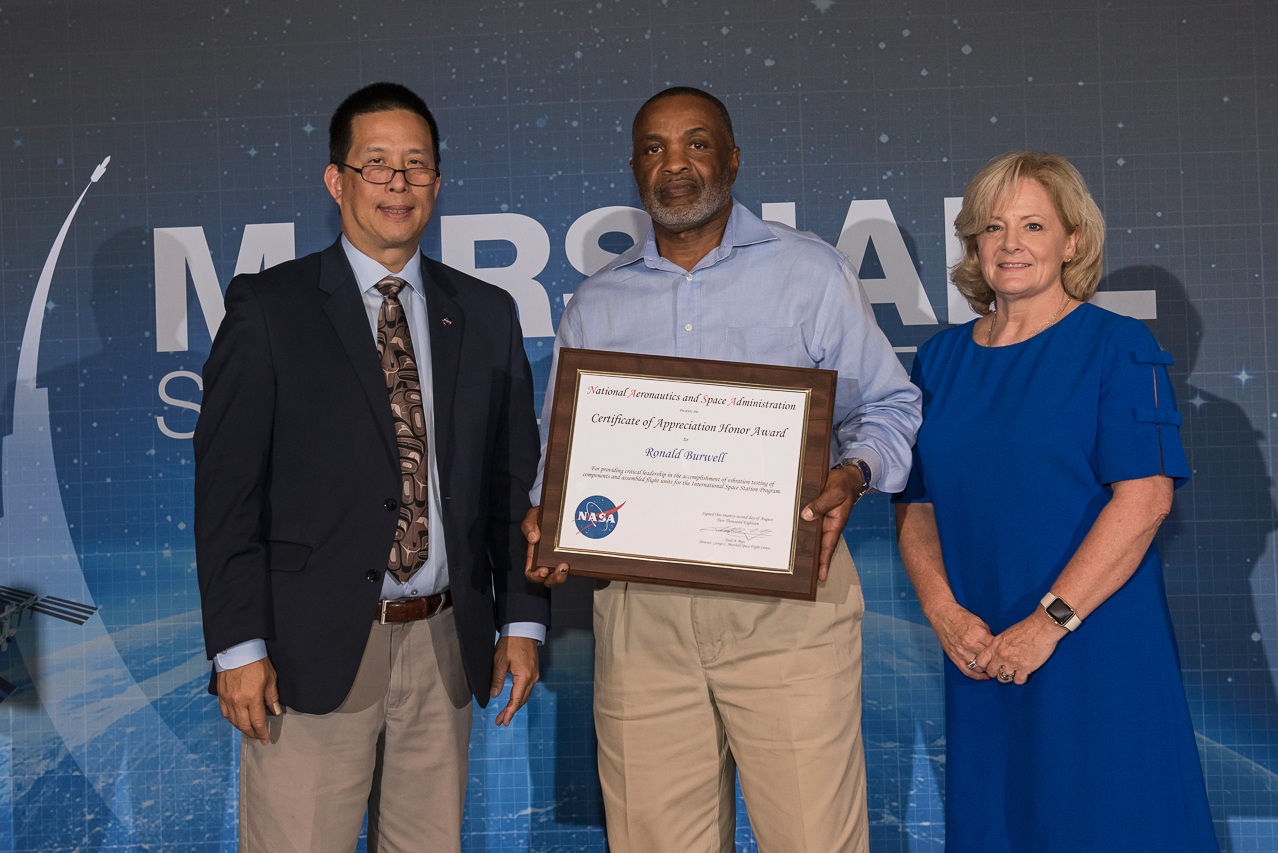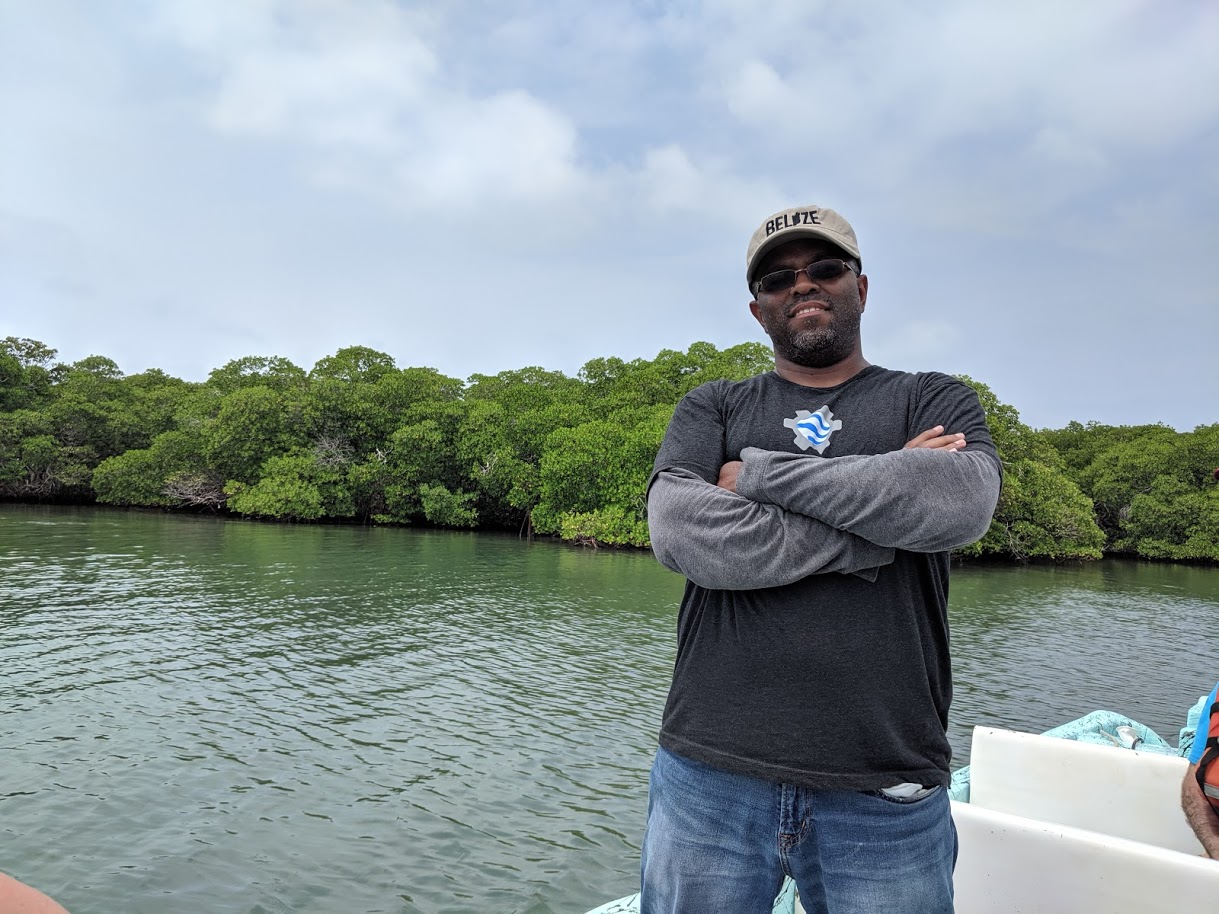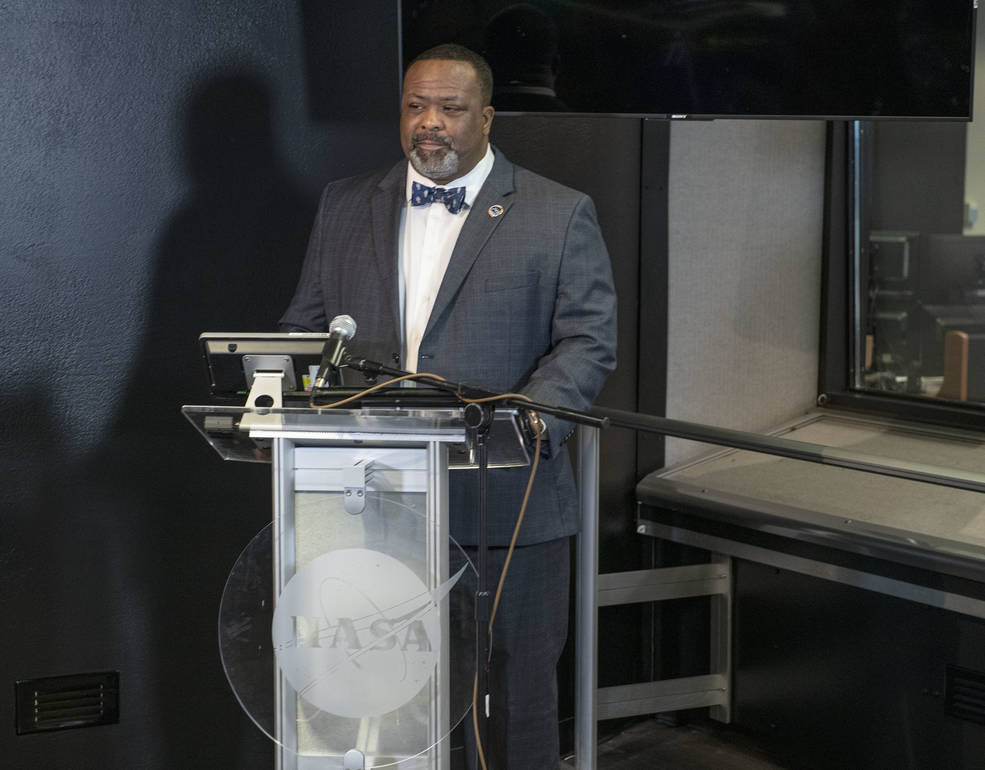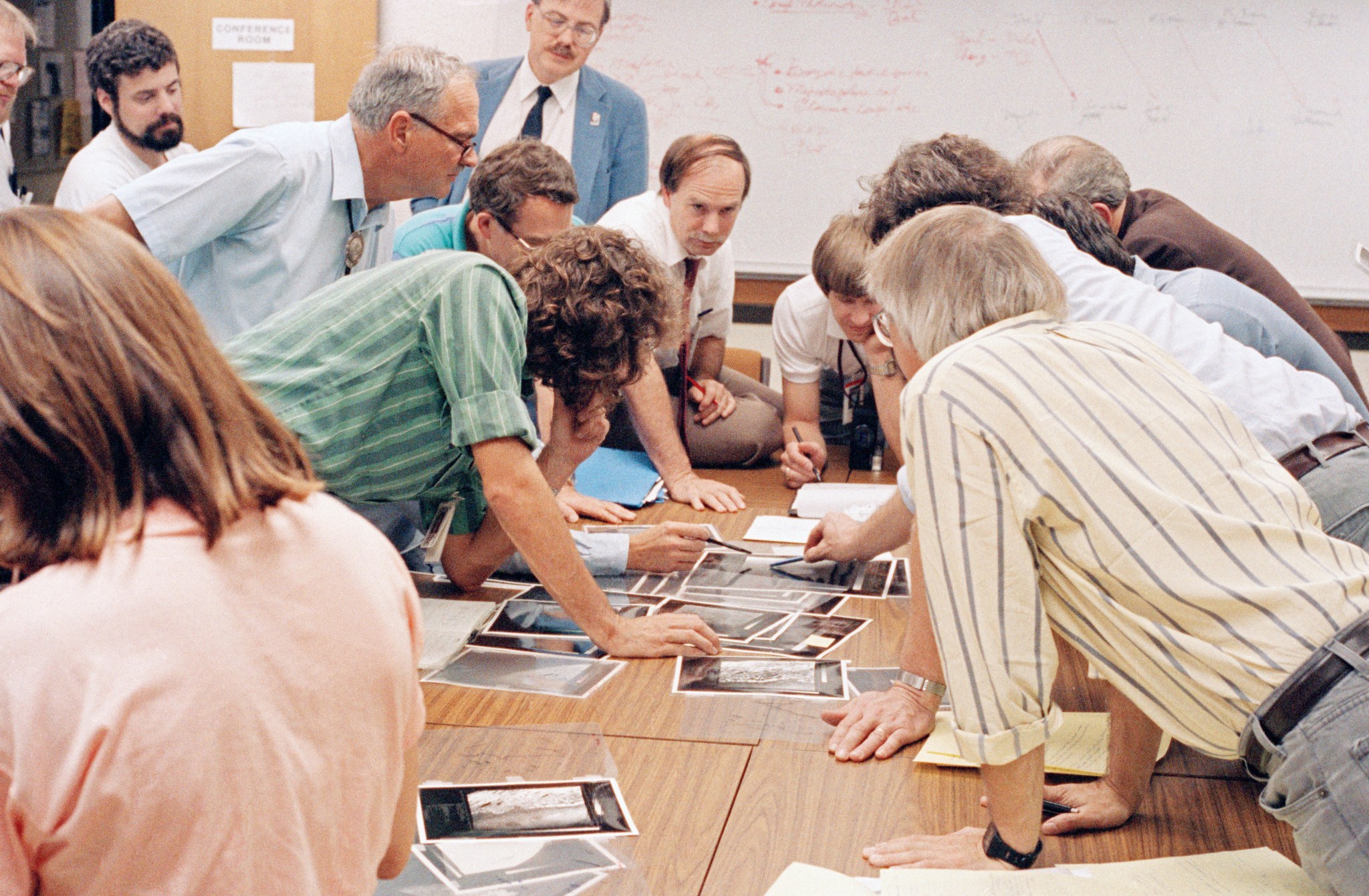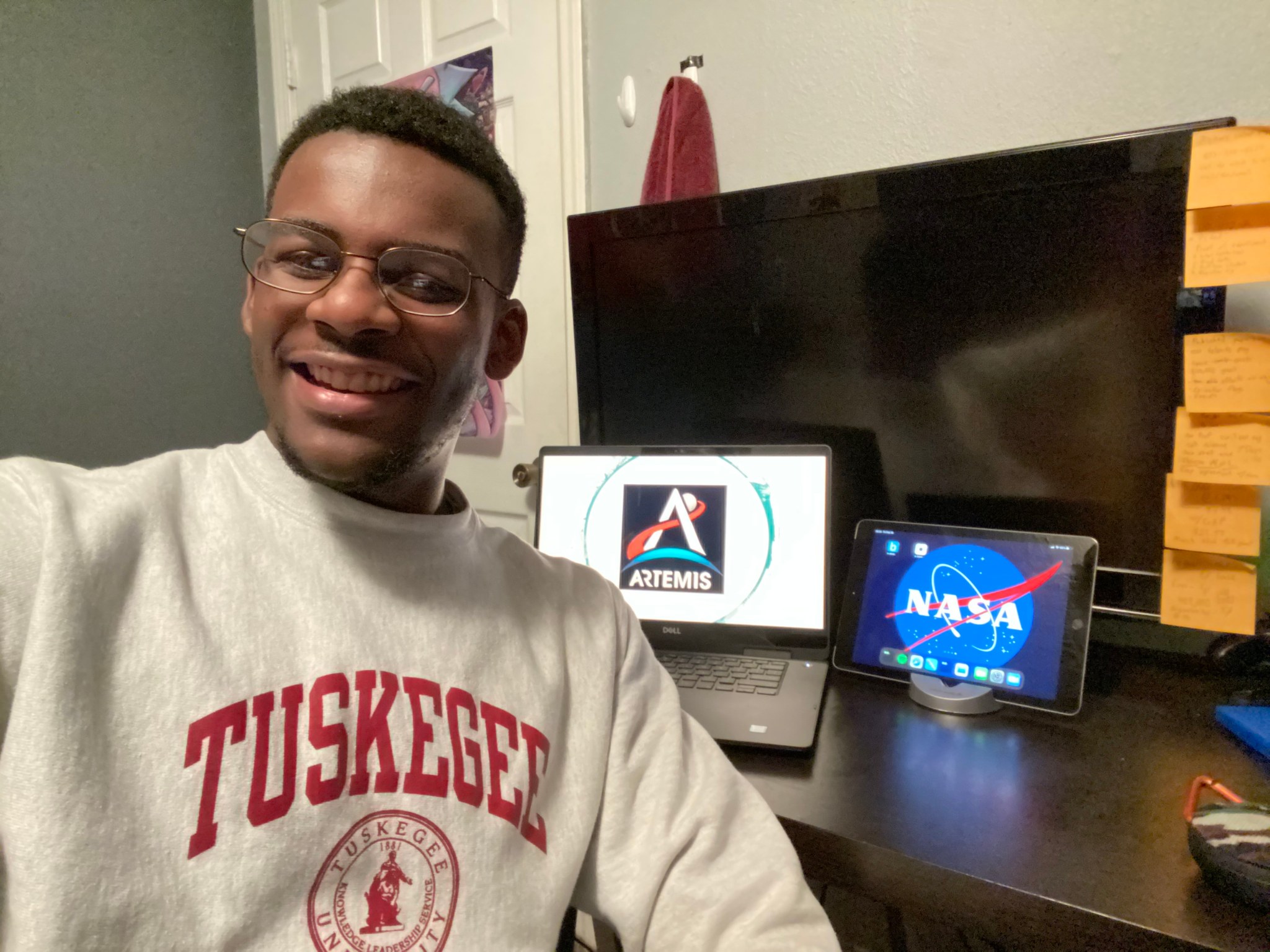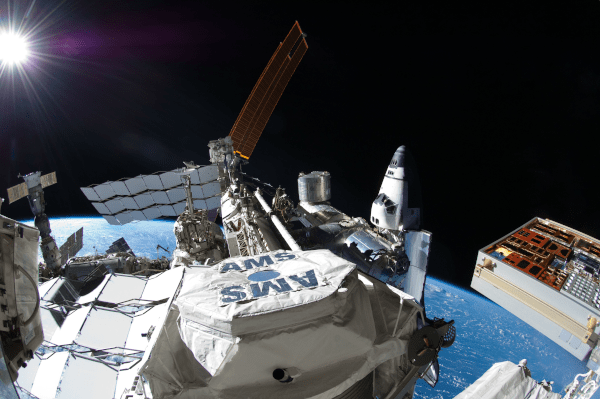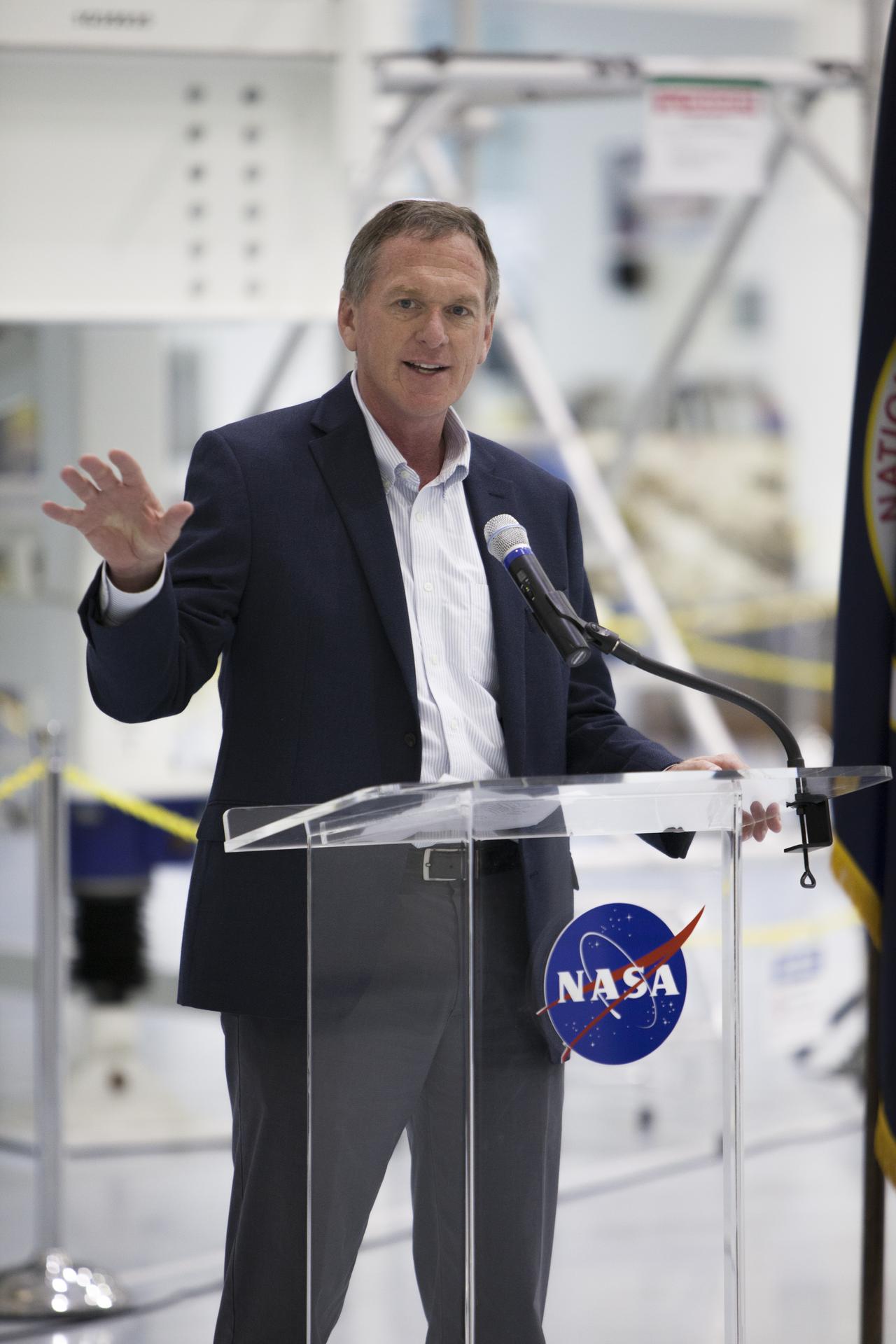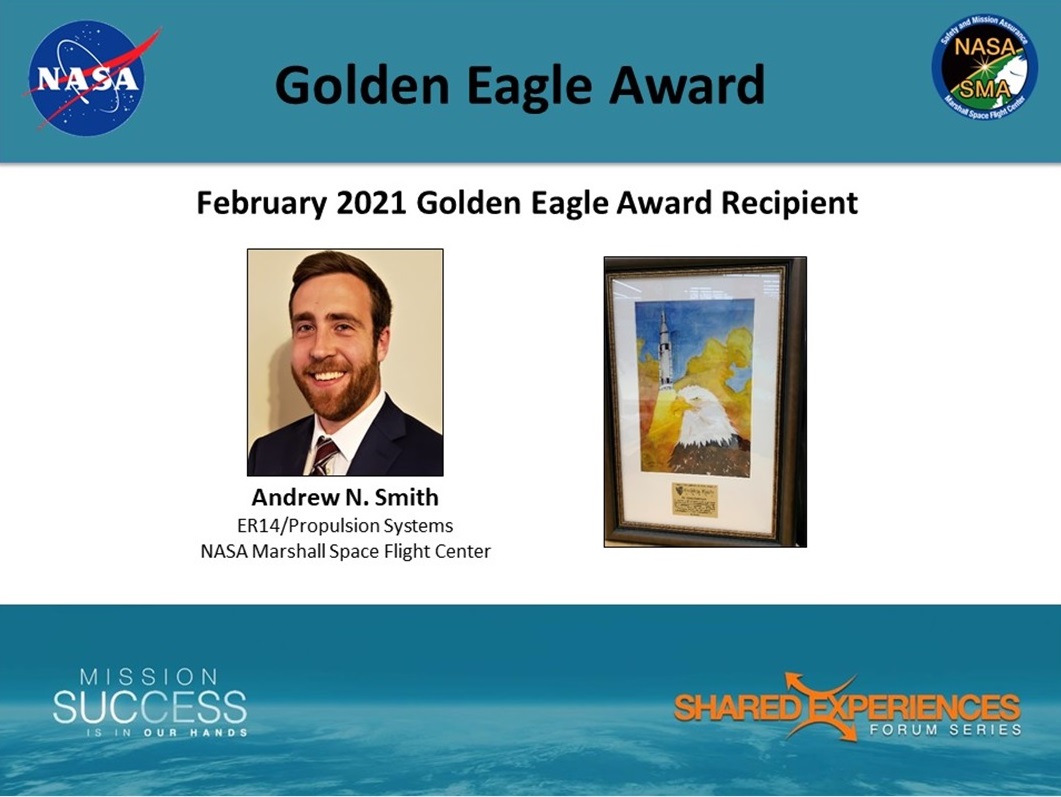In This Week’s Star
- NASA’s Mars Perseverance Rover Safely Lands on Red Planet
- NASA Evaluating Valve Performance Before 2nd Green Run Hot Fire Test
- NASA Welds Confidence Article for Evolved SLS Upper Stage
- 6 Team Members Honored with Trailblazer Award
- Marshall Celebrates Black History Month: Together We Achieve
- Marshall Highlights 7 Black Engineers for National Engineers Week
- Interns, Mentors Adapt to Virtual Environment
- 20 years of Space Station: Collecting, Understanding, Enabling Learning, Identifying the Unknown
- Exploration Ground System Manager Mike Bolger Says Understanding, Managing Risks Key to Launch Mission Management
- Team Members Deliver Learning Materials to Local Schools
- This Week in NASA History: Second Hubble Servicing Mission – Feb. 21, 1997
NASA’s Mars Perseverance Rover Safely Lands on Red Planet
On the afternoon of Feb. 18, people around the world held their breath in anticipation of NASA’s Perseverance rover landing – the largest and most complex of its kind sent to the Red Planet.
A journey seven months in the making, and a steady rhythm of its “heartbeat” throughout the 127 million miles of space between Earth and Mars, some of the only updates. For mission control teammates at NASA’s Jet Propulsion Laboratory, who helped monitor that journey, the wait would be rewarded seven minutes after the rover’s descent through the Martian atmosphere. At that moment, jubilation erupted. The rover got its wheels safely in the famed red dirt.
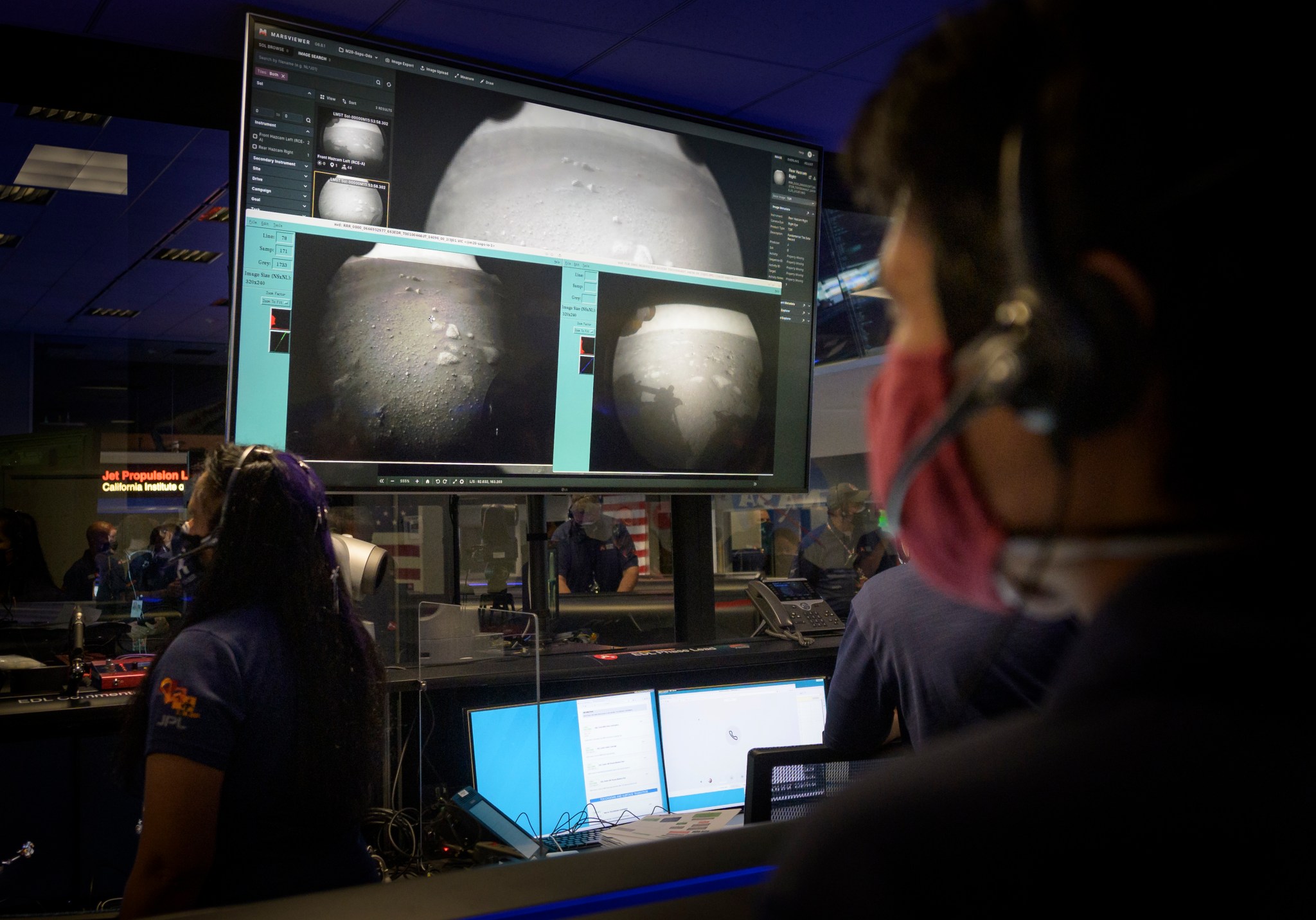
Perseverance was on Mars. Confirmation of the successful touchdown was announced in mission control at 2:55 p.m.
Packed with groundbreaking technology, the Mars 2020 mission launched July 30, 2020, from Cape Canaveral Space Force Station in Florida and made the multimillion- mile journey. Perseverance marks an ambitious first step in the effort to collect Mars samples and return them to Earth.
“This landing is one of those pivotal moments for NASA, the United States, and space exploration globally – when we know we are on the cusp of discovery and sharpening our pencils, so to speak, to rewrite the textbooks,” acting NASA Administrator Steve Jurczyk said. “The Mars 2020 Perseverance mission embodies our nation’s spirit of persevering even in the most challenging of situations, inspiring and advancing science and exploration. The mission itself personifies the human ideal of persevering toward the future and will help us prepare for human exploration of the Red Planet in the 2030s.”
Team members at NASA’s Marshall Space Flight Center played an important role in the mission, including planetary scientist Caleb Fassett, who championed Jezero Crater, named for the municipality of Jezero in Bosnia and Herzegovina, as the mission’s landing site.
“What the JPL and NASA teams have done today is nothing short of extraordinary,” Marshall Director Jody Singer said. “Marshall Space Flight Center is proud to be a part of this trailblazing endeavor, as we are developing the Mars Ascent Vehicle. Eventually, we’re going to rocket those samples from Perseverance into an orbit around Mars to bring them back to Earth.”
About the size of a small car such as a Mini Cooper, the 2,263-pound robotic geologist and astrobiologist will undergo several weeks of testing before it begins a two-year science investigation of Jezero Crater. While the rover will investigate the rock and sediment of Jezero’s ancient lakebed and river delta to characterize the region’s geology and past climate, a fundamental part of its mission is astrobiology, including the search for signs of ancient microbial life. To that end, the Mars Sample Return campaign, being planned by NASA and the European Space Agency, will allow scientists on Earth to study samples collected by Perseverance to search for definitive signs of past life using instruments too large and complex to send to the Red Planet.
The audio embedded in the video comes from the mission control call-outs during entry, descent, and landing. Credits: NASA/JPL-Caltech
“Because of today’s exciting events, the first pristine samples from carefully documented locations on another planet are another step closer to being returned to Earth,” said Thomas Zurbuchen, associate administrator for science at NASA. “Perseverance is the first step in bringing back rock and regolith from Mars. We don’t know what these pristine samples from Mars will tell us. But what they could tell us is monumental – including that life might have once existed beyond Earth.”
Some 28 miles wide, Jezero Crater sits on the western edge of Isidis Planitia, a giant impact basin just north of the Martian equator. Scientists have determined that the crater had its own river delta and was filled with water 3.5 billion years ago.
The power system that provides electricity and heat for Perseverance through its exploration of Jezero Crater is a Multi-Mission Radioisotope Thermoelectric Generator. The U.S. Department of Energy provided it to NASA through an ongoing partnership to develop power systems for civil space applications.
Equipped with seven primary science instruments, the most cameras ever sent to Mars, and its exquisitely complex sample caching system – the first of its kind sent into space – Perseverance will scour the Jezero region for fossilized remains of ancient microscopic Martian life, taking samples along the way.
“Perseverance is the most sophisticated robotic geologist ever made, but verifying that microscopic life once existed carries an enormous burden of proof,” said Lori Glaze, director of NASA’s Planetary Science Division. “While we’ll learn a lot with the great instruments we have aboard the rover, it may very well require the far more capable laboratories and instruments back here on Earth to tell us whether our samples carry evidence that Mars once harbored life.”
For more about Perseverance, visit here.
NASA Evaluating Valve Performance Before 2nd Green Run Hot Fire Test

NASA is reviewing the performance of a valve on the core stage of its Space Launch System rocket before proceeding with a second Green Run hot fire test at NASA’s Stennis Space Center. During test checkout preparations, engineers determined that one of the eight valves was not properly working. The valve is part of the core stage main propulsion system that supplies liquid oxygen to an RS-25 engine. During the first hot fire Jan. 16, all four liquid oxygen valves performed as expected as did the four liquid hydrogen valves. NASA and Boeing, the core stage lead contractor, will identify a path forward in the days ahead and reschedule the hot fire test that was originally targeted for Feb. 25. For the latest Green Run updates, visit the Artemis blog here. (NASA)
NASA Welds Confidence Article for Evolved SLS Upper Stage
Technicians are manufacturing the first in a series of initial weld confidence articles for the Exploration Upper Stage for future flights of NASA’s Space Launch System rocket at the agency’s Michoud Assembly Facility. The Exploration Upper Stage will be used on the second configuration of the SLS rocket, known as Block 1B, and will provide in-space propulsion to send astronauts in NASA’s Orion spacecraft and heavy cargo on a precise trajectory to the Moon. The Exploration Upper Stage weld confidence panels are first produced in the Vertical Weld Center at Michoud, then small sections of the panels are removed for mechanical testing and analysis in another area of the factory. Teams use weld confidence articles to verify welding procedures, interfaces between the tooling and hardware, and the structural integrity of the welds. Testing of the weld confidence articles will help engineers and technicians validate welding parameters to manufacture Exploration Upper Stage test and flight hardware. (NASA)
6 Team Members Honored with Trailblazer Award
By Taylor Goodwin
Six team members from NASA’s Marshall Space Flight Center were honored with the agency’s Space Flight Awareness Trailblazer Award in a virtual ceremony Feb. 4.
The annual award is presented to NASA civil servants and contractors who demonstrate strong work ethic and creative, innovative thinking in support of human spaceflight in the first seven years of their career. The Marshall recipients were Cara Black, Eric Fox, William Guin, Robbie Holcombe, Sriharsha Rayapati, and Andrew Watson.
“Our people serve a vital role in cultivating current and future leaders,” Marshall Director Jody Singer told the center’s awardees. “Specifically, your critical work is proof that the goals of this agency, and our center, are noteworthy and admirable pursuits.”
Astronaut Chris Cassidy, recently the commander of International Space Station Expedition 63, addressed award recipients and recounted a story about a 2013 spacewalk he performed with Italian astronaut Luca Parmitano. Parmitano’s’s helmet began filling with water and the pair had to return to the airlock. Cassidy said it became a full NASA effort to figure out the root cause of the issue and how to prevent it in the future.
“What’s most relatable to today,” Cassidy said, “is that this level of problem-solving to maintain mission safety is why you guys belong at NASA. Thank you for making spaceflight achievable, safe, and manageable. Never give up on your dream and doing the work you’re doing so well.”
Their accomplishments included:
- Cara Black, recognized for leadership and technical contributions toward advanced hydrogen purification technology development – which enables the exploration life support oxygen recovery goal of at least 75% of the oxygen contained in carbon dioxide produced by the crew.
- Eric Fox, demonstrated outstanding leadership in the research and development of ionic liquids for life support and in-situ resource utilization applications.
- William Guin was recognized for his innovative solutions and diligence in the development of bonded joins in composite dry structures relating to the Payload Adapter Project.
- Robbie Holcombe, for her outstanding leadership in the development of an Independent Government Cost Estimate for the SLS Stages Production Evolution contract and her excellent cost estimating and analysis in support of the development of a nuclear thermal propulsion system for human exploration.
- Sriharsha Rayapati, received his award for consistently achieving high-quality results in requirements development and integration tasks relation to the Space Launch System ground-based and airborne imagery system.
- Andrew Watson, received his award for exceptional leadership, dedication, and commitment to the Air Emissions Compliance and Resource Conservation and Recovery Act programs in Marshall’s Environmental Engineering & Occupational Health Office in support of NASA’s space exploration and science missions.
Each awardee received a certificate signed by Kathy Lueders, associate administrator for NASA’s Human Exploration and Operations Mission Directorate; a special commemorative spaceflight item; and the opportunity to shadow a NASA executive.
Goodwin, a Media Fusion employee, supports Marshall’s Office of Strategic Analysis & Communications.
Marshall Celebrates Black History Month: Together We Achieve
NASA’s Marshall Space Flight Center is celebrating Black History Month by highlighting the work and contributions of team members across the center. Whether supporting astronauts aboard the International Space Station, testing flight hardware, or developing and implementing the technologies of tomorrow, the values of unity, diversity, and inclusion are of great importance to the Marshall community. Each of the Marshall team members highlighted here fully embodies this year’s Marshall Black History Month celebration theme – “Representation, Identity and Diversity: Together We Achieve.”
Tawnya Laughinghouse
Title: Program manager, Technology Demonstration Missions
Hometown: Columbus, Ohio; and Huntsville, Alabama
Years with NASA: 17
My role at NASA: My role in TDM, the largest under NASA’s Space Technology Mission Directorate, is to manage large and diverse tech demo projects led by NASA centers across the agency and industry partners. Our technology projects include solar electric propulsion, deep space optical communication, On-orbit Servicing, Assembly, and Manufacturing and Entry, Descent and Landing technologies, to name a few. I am also responsible for managing an amazing team of folks here in the TDM Level 2 Program Office at Marshall.
What my work means to me: We have a saying the Space Technology Mission Directorate – “Technology drives exploration.” We look beyond the current state of the art to figure out what the future requires, what technologies will be needed, and how we can infuse and deliver those technologies not only for the mission needs of NASA, but also the needs of our government and commercial partners. So it gives me tremendous satisfaction knowing I have a hand in making sure we have the cutting edge in innovative technology that enables rewarding new space missions – missions that ultimately advance exploration and our understanding of the solar system in the universe around us.
The people who have influenced my life and career: My loving and supportive parents, E.J. Plummer Sr. and Linda, who put family first by moving back to Huntsville to raise their family in the Oakwood College (now Oakwood University) Seventh-day Adventist Church community, which shaped my faith and values. Mom and dad also showed by example their perseverance and tenacity through the highs and lows of life.
Rosa Kilpatrick, a Spelman College alumna and retired Marshall government and community relations specialist, introduced me to the NASA Women In Science and Engineering scholarship program when I first met her while participating in the NASA Summer High School Apprenticeship Research Program. I was ultimately awarded the scholarship and went on to major in chemistry and chemical engineering at Spelman College and Georgia Tech, respectively.
Timothy W. Lawrence, Gail Gordon, and Frank Ledbetter hired and nurtured me in the Marshall Materials & Processes Laboratory. They saw my potential and set me on a path to pursue leadership development opportunities at the center and the agency.
Rosalind Brewer, a fellow Spelman chemistry graduate, former Starbucks chief operating officer, and as the newly announced Walgreens CEO, will be the only Black woman CEO of a Fortune 500 company when she takes the helm in March 2021.
Stacey Abrams, a Spelman College classmate of mine, for her extraordinary grassroots impact on the 2020 presidential election in Georgia.
What the theme “Representation, Identity and Diversity: Together We Achieve” means to me: We live in a diverse nation, therefore our companies and our federal agencies ought to mirror that. In my career at NASA, I have observed that the best leaders cultivate a workforce with a range of experience levels, perspectives, capabilities, cultures, and backgrounds. Our differences and our strengths – along with a healthy dose of openness and trust – give us the freedom to engage in technical debates, welcome questions, be open to new ideas and solutions, and challenge the easy answers – all in the spirit of finding truth and making the best decisions. Whether you are a woman or a new hire or member of an underrepresented group – it shouldn’t matter. We must give everyone a voice, and it is my responsibility as a leader to foster that environment.
Ron Burwell
Title: Senior vibration test engineer
Hometown: Toney, Alabama
Years with NASA: 33
My role at NASA: I test and evaluate structural response issues of various spaceflight systems, subsystems, components, payloads, satellites, telescopes, etc., for NASA, other government entities, and industry. My team works with organizations across the board to test, document results, and aid in making decisions as to whether hardware will maintain structural integrity and is flight worthy according to NASA safety guidelines.
What my work means to me: My work gives me a great sense of accomplishment. After successful completion of every test and the subsequent analysis of test results, I feel that I’ve contributed to NASA’s overall mission and helped sustained the agency’s missions and values.
The people who have influenced my life and career: There are many people, starting with my parents who taught me the value of hard work and supported me at every level. Several instructors guided me towards a career in the science, technology, engineering, and math fields, and of course spiritual leaders who helped me maintain a sense of value and integrity.
What the theme “Representation, Identity and Diversity: Together We Achieve” means to me: I’m very pleased to see this year’s theme. The addition of inclusion as one of NASA’s core values shows NASA’s commitment to not only be a leader in science technology, aeronautics, and space exploration, but also to do it with a diverse workforce. A diverse team provides diverse opinions, which only enhances the results for all. I feel that now young people of all backgrounds with the motivation, hard work, and lots of studying will never feel that a career at NASA is beyond their reach. NASA’s core values of safety, integrity, excellence, and teamwork, along with inclusion, can only enhance NASA’s pursuit for excellence in all that we undertake.
Emil Cherrington
Title: West Africa Regional Science Coordination lead, SERVIR
Hometown: Belize City, Belize
Years with NASA: 4 (12 years with SERVIR)
My role at NASA: I’m a research scientist at the University of Alabama in Huntsville, and via UAH’s cooperative agreement with NASA, I provide science support to and coordinate with the SERVIR-West Africa consortium, which consists of six organizations in that region. I also coordinate closely with the U.S. Agency for International Development’s West Africa regional mission. Within the SERVIR Science Coordination Office, I provide support for land cover monitoring – one of SERVIR’s four thematic areas. Where SERVIR is also a part of the Applied Sciences Capacity Building Program, my work involves a substantial amount of capacity building, including providing training.
What my work means to me: Those of us working for programs like SERVIR – which is a unique partnership between NASA and the U.S. Agency for International Development – do so because we have seen the program’s impacts. SERVIR seeks to strengthen the capacity of users in its focus regions to apply Earth observation data from NASA and other agencies. Like a handful of my colleagues at the SERVIR Science Coordination Office, and what seems like a lifetime ago, I used to be one of the users SERVIR was targeting. That’s a perspective I’m thankful to have, because I remember what it was like to be on the other side of the table.
In SERVIR, which has been in operation for over 16 years now, we do what we do in part from the satisfaction that we are contributing to strengthening countries’ use of Earth observation data for the sustainable use of their resources. It’s ultimately also a part of NASA’s contribution, via the U.S. Group on Earth Observations, to the Group on Earth Observations’ work developing a Global Earth Observation System of Systems. We are ultimately helping to build a future where Earth observation data are better integrated into decision-making.
The people who have influenced my life and career: Honestly, there are too many people to name, stretching from my elementary school teachers to my advisors in grad school. However, SERVIR’s founder and Global Program Manager, Dan Irwin; former SERVIR International Programs Manager Gwen Artis; SERVIR Chief Scientist Ashutosh Limaye; and my UAH supervisor, Robert Griffin; have been important professional mentors. I am also thankful for my colleagues at the SERVIR Science Coordination Office, whose camaraderie I appreciate, and from whom I’ve also learned a great deal.
My family has also been an immense and supportive influence, from my parents to my wife, Betzy, to my grandparents, aunts, and uncles. My Aunt Carolyn gave me a computer as a gift when I was 14, which likely paved the way for my eventually entering the remote sensing field.
What the theme “Representation, Identity and Diversity: Together We Achieve” means to me: On a professional level, the SERVIR program for which I work has certainly recognized and celebrated the diversity of the regions in which we work. The people working for the overall SERVIR program hail from every inhabited continent, from different ethnic groups, languages, and faiths. The program has accomplished a great deal in its 16 years precisely because it has capitalized on such diverse perspectives.
If I reflect on “Together We Achieve,” as SERVIR is a partnership, I think about how it’s definitely an example that we are “better together.” SERVIR combines the strengths of a space agency with the strengths of a development agency – as well as the strengths of various centers of excellence from across the world. On a personal level, while “Representation, Identity, and Diversity” is the theme for Marshall’s Black History Month observance, I see the theme as transcending color or ethnicity, as it could be the theme for any month in that it is emblematic of America’s strength in being a melting pot of people from multiple cultures and origins. Isn’t that what “E pluribus unum” represents, after all?
Dwight Mosby
Title: Payload Mission Operations Division manager, International Space Station
Hometown: North Versailles, Pennsylvania
Years with NASA: 2
My role at NASA: I am a direct report to the Human Exploration Development & Operations Office at Marshall, and also report to the International Space Station Program manager at Johnson Space Center in Houston. I am responsible for cost, schedule, risk, and technical implementation of flight and ground operations activities in support of science missions.
What my work means to me: What makes my work meaningful is developing the next generation of space leaders supporting science and utilization and to delivering on our commitments to focus on crew safety, vehicle safety, and mission success.
The people who have influenced my life and career: Nathaniel Boclair III, who managed the Space Systems Operations branch at Marshall, was the most influential to my career. Personally, my mom, Janis Brooks. She raised two kids as a single parent while working on her Ph.D., which was not easy.
What the theme “Representation, Identity and Diversity: Together We Achieve” means to me: For fight control and ground operations, team building is essential to our success. It takes many people working together to support our principle investigators located all over the world. Our teams have to be diverse because diversity in individuals brings diversity in thought. Spaceflight is very dynamic and there are new challenges – sometimes daily. We overcome those challenges because we enable people with different perspectives to come together and figure out new solutions to new problems.
Visit here to watch video interviews with the highlighted team members.
Marshall Highlights 7 Black Engineers for National Engineers Week
In honor of National Engineers Week and Black History Month, NASA’s Marshall Space Flight Center highlighted seven engineers about their professional and personal experiences.
Visit here to learn about these engineers who are making a difference in space exploration and technology.
National Engineers Week (Feb. 21-27) is dedicated to ensuring a diverse, future engineering workforce by increasing an interest in and understanding of science, technology, engineering, and math careers.
Black History Month, also known as African American History Month, which is observed in the month of February, pays tribute to the generations of Black/African Americans who struggled with adversity to achieve full citizenship in American society.
Interns, Mentors Adapt to Virtual Environment
By Taylor Goodwin
As the workforce at NASA’s Marshall Space Flight Center approaches a year of working virtually in response to COVID-19, the center continues to welcome interns to contribute to the agency’s missions of human spaceflight, space science, and Earth research. While the overall experience may look different than traditional academic terms, NASA is dedicated to giving students the most valuable experience possible.
“The agency’s main goal is to encourage students to pursue careers in science, technology, engineering, and mathematics,” said Lynnette Madison, NASA internships manager. “Even in an unconventional setting, we have been adapting our program to offer interns and mentors a solid experience that supports NASA’s missions.”
NASA’s Southeast Regional STEM Engagement Office – which manages engagement activities at Marshall and Stennis Space Center – has been working to adapt and create meaningful opportunities for both mentors and interns. Key deadlines are approaching for upcoming sessions, as mentors can submit projects for summer 2021 intern opportunities until Feb. 26, and interns can submit applications until March 5.
While the process has been a change for both mentors and interns, many have accepted the challenge and even found benefits to the online program.
“One way to express our gratitude for the opportunities we have at NASA is to create opportunities for others,” said John Dankanich, Marshall’s chief technologist, who has mentored many interns. “The NASA workforce excels at adapting to changing environments, and every challenge should be perceived as an opportunity for growth.”
For Marshall intern Nathaniel Lazard, the online aspect of the opportunity was one of the main reasons he applied. “Being a senior in my last semester, having the opportunity to be on-site for this internship would have been exciting,” he said, “but the flexibility the virtual environment offers allows my mentor and I to work with my class schedule.”
Lazard is completing open-sourced research concerning the international use of manufacturing techniques developed for the Artemis program. Though he is in the early stages of his spring internship term, he said he is already learning a lot about NASA operations and where he could fit in as a professional. “Due to the nature and necessity of the virtual experience, there are times where I personally feel like I’m a little fish in a big pond, but my mentor does an amazing job of connecting the dots to help me understand the purpose of the work I am doing,” he said.
Under typical circumstances, interns might be assigned hands-on learning opportunities, such as working in a lab or with hardware. While this on-site work is not viable at the time, mentors like Dankanich modified the intern experience by increasing the number of formal one-on-one meetings and making a greater effort to validate the intern’s comfort level with assigned projects. His student is currently working to communicate the recent Marshall technology innovations and creating products for the program’s website.
“There are always benefits to having interns supporting NASA projects,” Dankanich said. “The obvious direct benefit is an extra set of hands to accomplish the work, but the secondary benefits are just as important. Interns are a new set of eyes that bring new approaches to the team or have the ability to identify improvement opportunities. Interns also have an incredible energizing impact on the team.”
Dankanich and Lazard say they would encourage both students and mentors to reach outside of their comfort zone to pursue this rewarding experience.
“Working at NASA is a blessing,” Dankanich said. “Continuing to engage interns requires adaptation, but also helps maintain the sense of normalcy. Even during the COVID-19 environment, NASA is obligated to inspire and train the future STEM pipeline.”
For more information on mentor and internship opportunities at Marshall, contact a member of Marshall’s Office of STEM Engagement staff.
20 years of Space Station: Collecting, Understanding, Enabling Learning, Identifying the Unknown
Editor’s note: This is the fourth in a five-part series highlighting scientific and technological breakthroughs that have been achieved over the past two decades as a result of International Space Station science. This research helps humanity explore farther into space while also benefiting life on Earth. The Payload Operations Integration Center at NASA’s Marshall Space Flight Center schedules, assists with, and coordinates all experiments on the station’s U.S. Orbital Segment.
For 20 years, the crew aboard the International Space Station has conducted long-duration research in microgravity – a feat possible only within the orbiting laboratory. This research led to numerous discoveries, scientific publications, unique opportunities, and historic breakthroughs that provide benefits to space travel and life on Earth. Among these breakthroughs, astronauts have collected data on more than 100 billion cosmic particles, gained a better understanding of pulsars and black holes, provided student access to the space station, and developed the capability to identify unknown microbes in space.
Collecting data on cosmic particles: Many scientists theorize that stars, planets, and the molecules that compromise them are less than 5% of the mass-energy content of the universe. The rest is dark matter – invisible matter that cannot be detected directly but can be inferred. The Alpha Magnetic Spectrometer – 02, or AMS-02, has been looking for evidence of this substance from the space station since 2011, collecting data on more than 100 billion cosmic particles.
AMS-02’s core is a massive magnet that bends incoming charged particles. The direction they bend reveals their charge, which helps identify the type of particle. Earth’s atmosphere has a significant effect on these particles, so a space-based observatory is essential in obtaining accurate information.
AMS-02 has provided researchers with data that can help determine what the universe is made of and how it began. It also has collected data on cosmic rays, how these rays travel through space, and what produces them. In addition to helping unravel scientific mysteries of the universe, AMS-02 may also allow scientists to get a more complete picture of radiation in space.
Better understanding of pulsars and black holes: Two tools installed on the outside of the space station have worked in tandem to advance knowledge of pulsars and black holes: NASA’s Neutron star Interior Composition Explorer, or NICER, and the Monitor of All-sky X-ray Image, or MAXI, from the Japan Aerospace Exploration Agency.
In 2018, MAXI detected a new X-ray source in the sky and named it “MAXI J1820+070.” Shortly after, NICER began monitoring the source and determined it to be a black hole binary system containing a black hole with a mass several times that of the Sun. Within days, MAXI J1820+070 became one of the brightest X-ray sources in the sky. NICER tracked the evolution of this system. Its measurements helped scientists understand how the inner edge of a black hole’s accretion disk – and the corona above it – change in size and shape as a black hole consumes material from a star.
Student access: Numerous programs have given elementary- to college-aged students access to space and the chance to take advantage of the microgravity environment aboard the space station. More than 950,000 students have participated in EarthKAM – Earth Knowledge Acquired by Middle school students, taking pictures of Earth using a station camera. HUNCH – High school students United with NASA to Create Hardware – has partnered with schools to send more than 1,300 student-made items to the station. The Genes in Space and Guardians of the Galaxy Space Station Challenge competitions have given high school students the opportunity to design experiments flown into orbit. Millions of children have also participated in Tomatosphere, which provides students with tomato seeds exposed to space or space-simulated environments and seeds that have not – allowing classrooms to compare how the seeds grow. In addition, students have the opportunity to talk with astronauts in space through NASA’s STEM on Station and amateur radio on the International Space Station.
Identifying unknown microbes: A space-based DNA sequencer is an important tool to help protect astronaut heath during long-duration missions on the journey to Mars, aiding in the ability to diagnose and treat astronaut ailments in real time. Future explorers also could use the technology to identify DNA-based life forms beyond Earth.
Being able to identify microbes in space in real time – without having to send them back to Earth for identification – is revolutionary for the world of microbiology and space exploration. The Genes in Space-3 team proved this can be done when they completed the first sample-to-sequence process entirely aboard the space station in 2017. Crew members collected a sample, isolated the DNA, prepped it, and then sequenced the unknown DNA. In the months leading up to this test, NASA astronaut Kate Rubins also conducted the first DNA sequencing in space.
Team members are invited to save the date for the 20th anniversary celebration of ISS payload operations March 17. The event will feature stories from payload operations team members and friends over the last two decades, as well as a look ahead to the future. A link to the event will be shared soon, but employees can join the celebration now by clicking here to get involved.
Exploration Ground System Manager Mike Bolger Says Understanding, Managing Risks Key to Launch Mission Management
By Will Bryan
Mike Bolger – program manager of NASA’s Exploration Ground Systems at the agency’s Kennedy Space Center – views safety and risk management as the launch keys for the next world-changing missions. Bolger’s team is in charge of the systems that will launch NASA’s Space Launch System rocket and the Artemis missions, and on Feb. 18 via Webex, he delivered the first Mission Success is in Our Hands talk of 2021.
Bolger became the program’s manager in 2013 and has witnessed the evolution of NASA’s deep space human exploration architecture over the past eight years. During that time, the team encountered multiple challenges that required them to stop, reevaluate, and make changes to infrastructure and equipment to enable the rocket and its payloads to launch safely and successfully.
There were also things outside of the team’s control, including devastatingly active hurricane seasons and the COVID-19 pandemic. Bolger received advice to always anticipate challenges that could impact the schedule and the mission, then document those obstacles and the anticipated solutions. Lessons learned from the past play a vital role in forecasting what could and will likely become speed bumps on the path to the Moon and Mars.
Bolger also said there are key characteristics to navigating challenges, including resilience and perseverance. Another important facet is providing the team members working on the equipment authority to accept risk and the knowledge of what that acceptable risk level is.
Prior to Bolger’s presentation, Andrew Smith was honored with the Golden Eagle Award, presented to team members who make significant, identifiable contributions to flight safety and mission success. Smith was viewing a vendor test of an SLS core stage check valve when he saw that part of the test procedure required someone to adjust a control near a high pressure point. Smith – using the safety authority granted to all Marshall team members – raised the concern. In less than four hours, a system to remotely adjust the control was developed and implemented, and the test was completed safely and successfully.
Marshall’s Safety and Mission Assurance Directorate, with partner Jacobs Engineering, promote awareness and appreciation for the connections between team members’ everyday activities, the overall success of NASA and Marshall missions, and the safety of astronauts through the Mission Success is in Our Hands program. The next talk will be April 15 and feature Russ DeLoach, the chief of Safety and Mission Assurance at NASA Headquarters.
To learn more about the program, visit here.
Bryan, a Manufacturing Technical Solutions employee, supports Marshall’s Office of Strategic Analysis & Communications.
Team Members Deliver Learning Materials to Local Schools
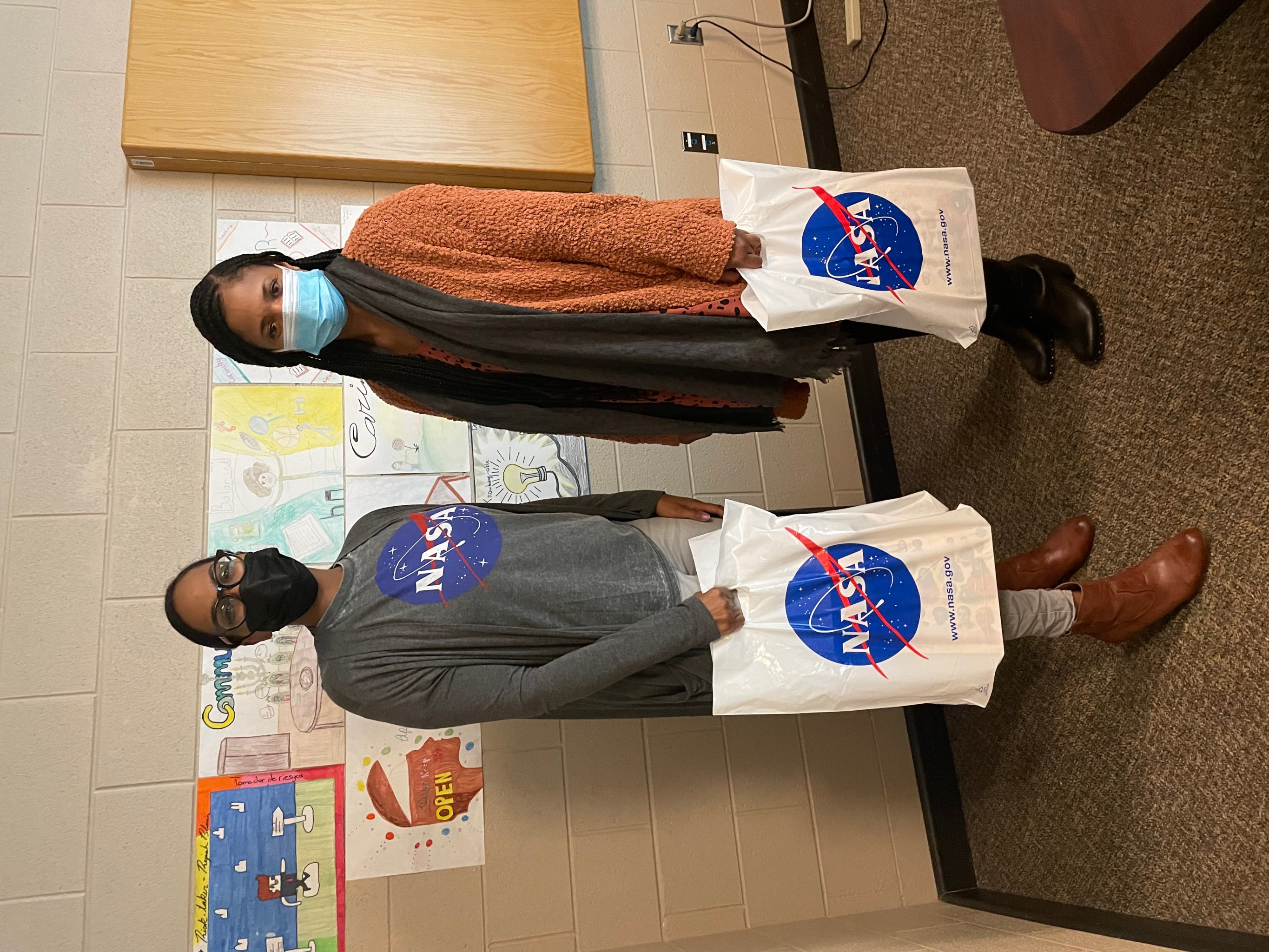
Camille Williams, left, a Manufacturing Technical Solutions Inc. project coordinator at NASA’s Marshall Space Flight Center, helps deliver NASA learning materials to Melissa Veasy-Lindsey, principal of Williams Middle School in Huntsville, on Feb. 9. Williams and other Marshall team members delivered the materials as part of Black History Month outreach, and to foster a partnership with the school and Marshall’s African American Advisory Working Group. The group leads outreach opportunities with local schools, and implements events to promote inclusion for all members of the center’s workforce. (NASA)
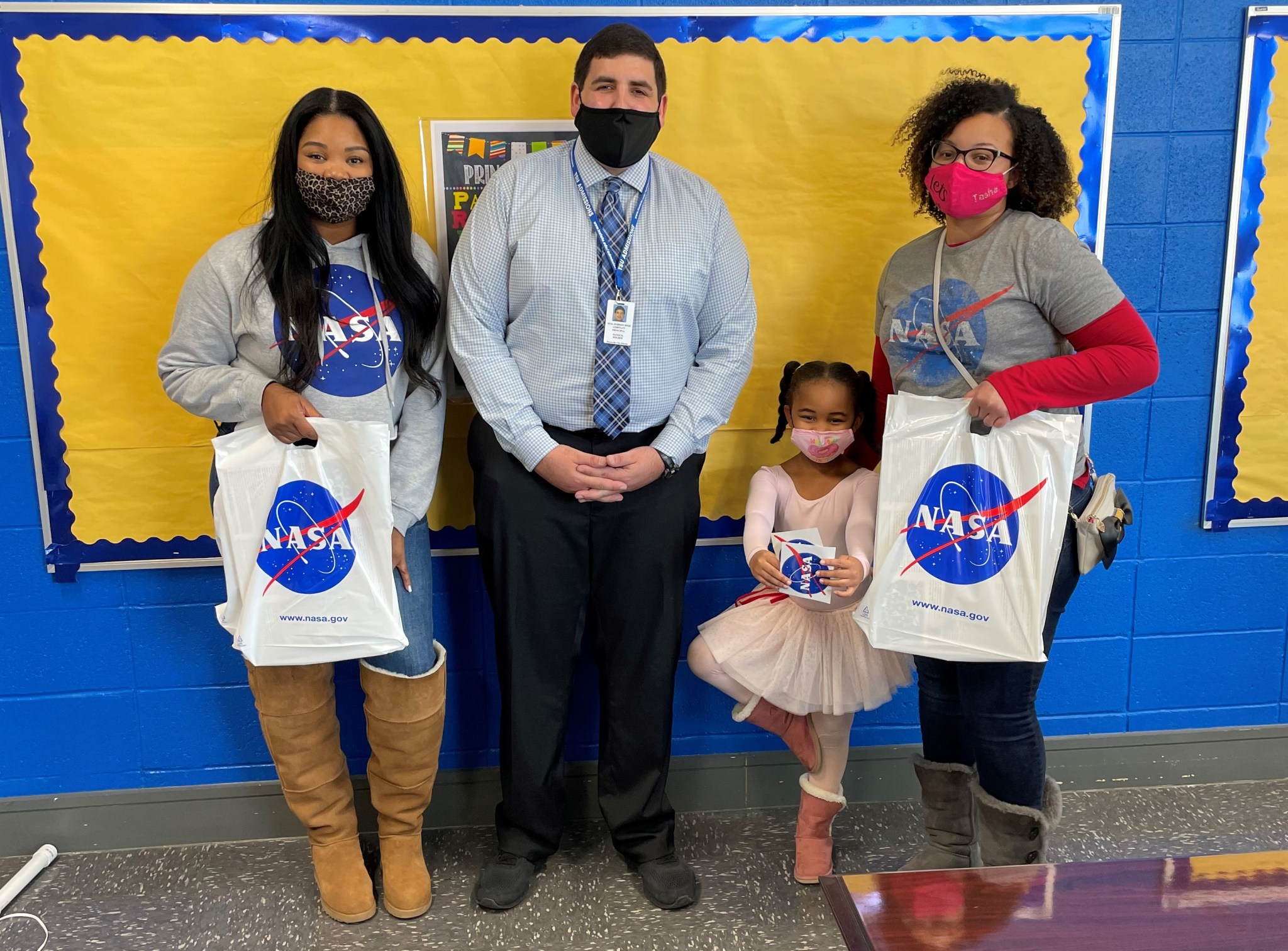
From left, Amanda Otieno, a Marshall equal employment specialist; Patrick Holder, assistant principal of Mae Jemison High School; Peyton Fields, and her mother, Yotodsha Fields, a Teledyne Brown project engineer at Marshall. Otieno and Fields delivered NASA learning materials to Williams Middle School on Feb. 9. (NASA)
This Week in NASA History: Second Hubble Servicing Mission – Feb. 21, 1997
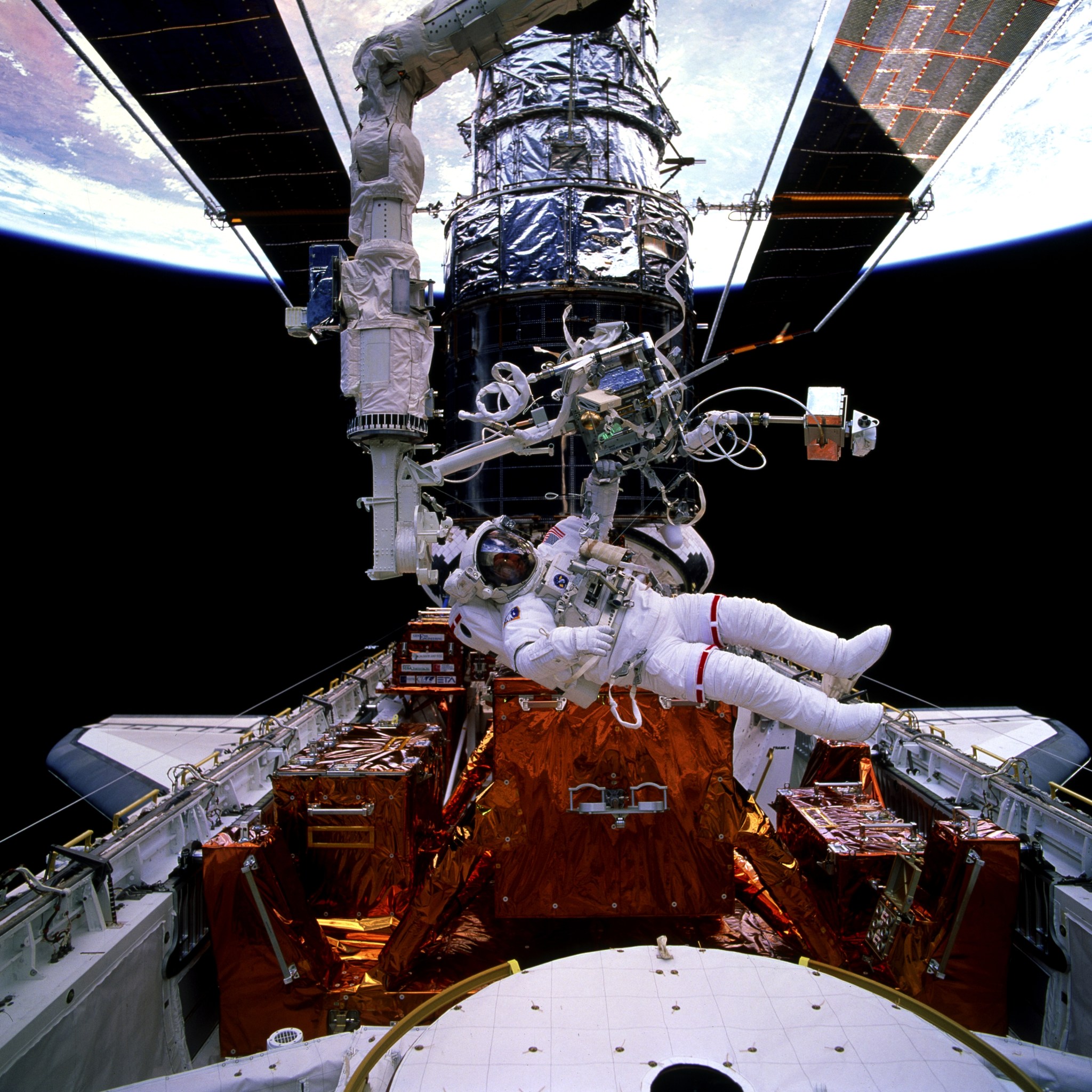
This week in 1997, space shuttle Discovery, mission STS-82, landed at NASA’s Kennedy Space Center following a successful nine-day mission to service the Hubble Space Telescope. Here, astronaut Gregory J. Harbaugh floats while Hubble is docked in the orbiter’s cargo bay. This was the second Hubble servicing mission. The NASA History Program is responsible for generating, disseminating, and preserving NASA’s remarkable history and providing a comprehensive understanding of the institutional, cultural, social, political, economic, technological, and scientific aspects of NASA’s activities in aeronautics and space. For more pictures like this one and to connect to NASA’s history, visit the Marshall History Program’s webpage. (NASA)















